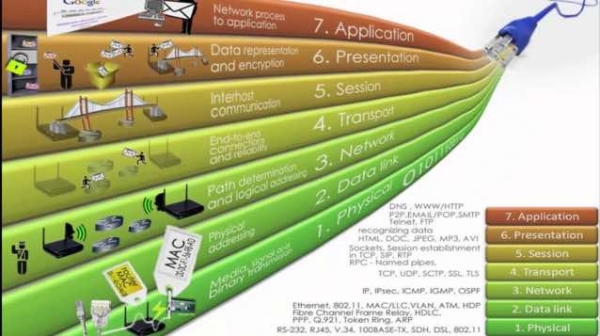Recently, I have been writing a lot over network topology, computer networks, and network devices. However, with time, I realized that if I continue writing more networking things, I need to write about the basics of computer networking i.e. OSI model. This will help the readers to relate it with the famous OSI model and at different points.
Also, When I would feel a need of guiding a reader to read about the networking basics and fundamentals like OSI model, I can simply put up a link there.
So, here I go:
What is OSI model?
The OSI model (Open System Interconnection) model defines a computer networking framework to implement protocols in seven layers. A protocol in the networking terms is a kind of negotiation and rule in between two networking entities.
Layers of OSI model:
Physical layer
The Physical layer is also called as the Layer 1. Here are the basic functionalities of the Physical layer:
- Responsible for electrical signals, light signal, radio signals etc.
- Hardware layer of the OSI layer
- Devices like repeater, hub, cables, ethernet work on this layer
- Protocols like RS232, ATM, FDDI, Ethernet work on this layer
Data Link layer
The data link layer is also called as the Layer 2 of the OSI model. Here are the basic functionalities of the data link layer:
- Responsible for encoding and decoding of the electrical signals into bits.
- Manages data errors from the physical layer
- Convers electrical signals into frames
- The data link layer is divided into two sub-layers
- The Media Access Control (MAC) layer
- Logical Link Control (LLC) layer.
- The MAC sublayer controls how a computer on the network gains access to the data and permission to transmit it.
- The LLC layer controls frame synchronization, flow control and error checking.
- MAC address is a part of the layer 2.
- Devices like Switch work at this layer
Network Layer
The Network layer is also called as the layer 3 of the OSI model. Here are the basic functionalities of the network layer:
- Switching and routing technologies work here
- Creates logical paths between two hosts across the world wide web called as virtual circuits
- Routes the data packet to destination
- Routing and forwarding of the data packets.
- Internetworking, error handling, congestion control and packet sequencing work at this layer
- Router works at layer three
- Different network protocols like TCP/ IP, IPX, AppleTalk work at this layer
Transport layer
The Transport layer is also called as the layer 4 of the OSI model. Here are the basic functionalities of the Transport layer:
- Responsible for the transparent transfer of data between end systems
- Responsible for end-to-end error recovery and flow control
- Responsible for complete data transfer.
- Protocols like SPX, TCP, UDP work here
Session layer
The Session layer is also called as the layer 5 of the OSI model. Here are the basic functionalities of the Session layer:
- Responsible for establishment, management and termination of connections between applications.
- The session layer sets up, coordinates, and terminates conversations, exchanges, and dialogues between the applications at each end.
- It deals with session and connection coordination.
- Protocols like NFS, NetBios names, RPC, SQL work at this layer.
Presentation layer
The Presentation layer is also called as the layer 6 of the OSI model. Here are the basic functionalities of the presentation layer:
- Responsible for data representation on your screen
- Encryption and decryption of the data
- Data semantics and syntax
- Layer 6 Presentation examples include encryption, ASCII, EBCDIC, TIFF, GIF, PICT, JPEG, MPEG, MIDI.
Application Layer
The Application layer is also called as the layer 7 of the OSI model. Here are the basic functionalities of the Application layer:
- Application layer supports application, apps, and end-user processes.
- Quality of service
- This layer is responsible for application services for file transfers, e-mail, and other network software services.
- Protocols like Telnet, FTP, HTTP work on this layer.




